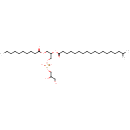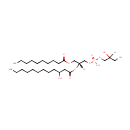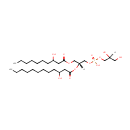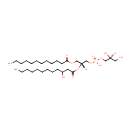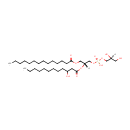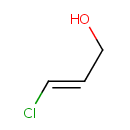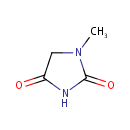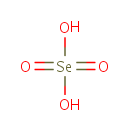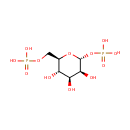
Search Results for compounds
Searching compounds for
returned 4373 results.
Displaying compounds 2181 - 2190 of
4373 in total
PG(10:0/19:iso) (PAMDB004038)
IUPAC:
[3-(decanoyloxy)-2-[(17-methyloctadecanoyl)oxy]propoxy](2,3-dihydroxypropoxy)phosphinic acid
CAS: Not Available
Description: PG(10:0/19:iso) is a phosphatidylglycerol. Phosphatidylglycerols consist of a glycerol 3-phosphate backbone esterified to either saturated or unsaturated fatty acids on carbons 1 and 2. As is the case with diacylglycerols, phosphatidylglycerols can have many different combinations of fatty acids of varying lengths and saturation attached to the C-1 and C-2 positions. PG(10:0/19:iso), in particular, consists of one decanoyl chain to the C-1 atom, and one 17-methylocatdecanoyl to the C-2 atom. In Pseudomonas aeruginosa glycerophospholipid metabolism, phosphatidylglycerol is formed from phosphatidic acid (1,2-diacyl-sn-glycerol 3-phosphate) by a sequence of enzymatic reactions that proceeds via two intermediates, cytidine diphosphate diacylglycerol (CDP-diacylglycerol) and phosphatidylglycerophosphate (PGP, a phosphorylated phosphatidylglycerol). Phosphatidylglycerols, along with CDP-diacylglycerol, also serve as precursor molecules for the synthesis of cardiolipin, a phospholipid found in membranes.
PG(12:0(3-OH)/10:0) (PAMDB004039)
IUPAC:
[(2R)-3-(decanoyloxy)-2-[(3-hydroxydodecanoyl)oxy]propoxy][(2S)-2,3-dihydroxypropoxy]phosphinic acid
CAS: Not Available
Description: PG(12:0(3-OH)/10:0) is a phosphatidylglycerol. Phosphatidylglycerols consist of a glycerol 3-phosphate backbone esterified to either saturated or unsaturated fatty acids on carbons 1 and 2. As is the case with diacylglycerols, phosphatidylglycerols can have many different combinations of fatty acids of varying lengths and saturation attached to the C-1 and C-2 positions. PG(12:0(3-OH)/10:0), in particular, consists of one 3-hydroxydodecanoyl chain to the C-1 atom, and one decanoyl to the C-2 atom. In Pseudomonas aeruginosa glycerophospholipid metabolism, phosphatidylglycerol is formed from phosphatidic acid (1,2-diacyl-sn-glycerol 3-phosphate) by a sequence of enzymatic reactions that proceeds via two intermediates, cytidine diphosphate diacylglycerol (CDP-diacylglycerol) and phosphatidylglycerophosphate (PGP, a phosphorylated phosphatidylglycerol). Phosphatidylglycerols, along with CDP-diacylglycerol, also serve as precursor molecules for the synthesis of cardiolipin, a phospholipid found in membranes.
PG(12:0(3-OH)/10:0(3-OH)) (PAMDB004040)
IUPAC:
[(2S)-2,3-dihydroxypropoxy][(2R)-3-[(3-hydroxydecanoyl)oxy]-2-[(3-hydroxydodecanoyl)oxy]propoxy]phosphinic acid
CAS: Not Available
Description: PG(12:0(3-OH)/10:0(3-OH)) is a phosphatidylglycerol. Phosphatidylglycerols consist of a glycerol 3-phosphate backbone esterified to either saturated or unsaturated fatty acids on carbons 1 and 2. As is the case with diacylglycerols, phosphatidylglycerols can have many different combinations of fatty acids of varying lengths and saturation attached to the C-1 and C-2 positions. PG(12:0(3-OH)/10:0(3-OH)), in particular, consists of one 3-hydroxydodecanoyl chain to the C-1 atom, and one 3-hydroxydecanoyl to the C-2 atom. In Pseudomonas aeruginosa glycerophospholipid metabolism, phosphatidylglycerol is formed from phosphatidic acid (1,2-diacyl-sn-glycerol 3-phosphate) by a sequence of enzymatic reactions that proceeds via two intermediates, cytidine diphosphate diacylglycerol (CDP-diacylglycerol) and phosphatidylglycerophosphate (PGP, a phosphorylated phosphatidylglycerol). Phosphatidylglycerols, along with CDP-diacylglycerol, also serve as precursor molecules for the synthesis of cardiolipin, a phospholipid found in membranes.
PG(12:0(3-OH)/12:0) (PAMDB004041)
IUPAC:
[(2S)-2,3-dihydroxypropoxy][(2R)-3-(dodecanoyloxy)-2-[(3-hydroxydodecanoyl)oxy]propoxy]phosphinic acid
CAS: Not Available
Description: PG(12:0(3-OH)/12:0) is a phosphatidylglycerol. Phosphatidylglycerols consist of a glycerol 3-phosphate backbone esterified to either saturated or unsaturated fatty acids on carbons 1 and 2. As is the case with diacylglycerols, phosphatidylglycerols can have many different combinations of fatty acids of varying lengths and saturation attached to the C-1 and C-2 positions. PG(12:0(3-OH)/12:0), in particular, consists of one 3-hydroxydodecanoyl chain to the C-1 atom, and one dodecanoyl to the C-2 atom. In Pseudomonas aeruginosa glycerophospholipid metabolism, phosphatidylglycerol is formed from phosphatidic acid (1,2-diacyl-sn-glycerol 3-phosphate) by a sequence of enzymatic reactions that proceeds via two intermediates, cytidine diphosphate diacylglycerol (CDP-diacylglycerol) and phosphatidylglycerophosphate (PGP, a phosphorylated phosphatidylglycerol). Phosphatidylglycerols, along with CDP-diacylglycerol, also serve as precursor molecules for the synthesis of cardiolipin, a phospholipid found in membranes.
PG(12:0(3-OH)/12:0(3-OH)) (PAMDB004042)
IUPAC:
[(2R)-2,3-bis[(3-hydroxydodecanoyl)oxy]propoxy][(2S)-2,3-dihydroxypropoxy]phosphinic acid
CAS: Not Available
Description: PG(12:0(3-OH)/12:0(3-OH)) is a phosphatidylglycerol. Phosphatidylglycerols consist of a glycerol 3-phosphate backbone esterified to either saturated or unsaturated fatty acids on carbons 1 and 2. As is the case with diacylglycerols, phosphatidylglycerols can have many different combinations of fatty acids of varying lengths and saturation attached to the C-1 and C-2 positions. PG(12:0(3-OH)/12:0(3-OH)), in particular, consists of two 3-hydroxydodecanoyl chains at positions C-1 and C-2. In Pseudomonas aeruginosa glycerophospholipid metabolism, phosphatidylglycerol is formed from phosphatidic acid (1,2-diacyl-sn-glycerol 3-phosphate) by a sequence of enzymatic reactions that proceeds via two intermediates, cytidine diphosphate diacylglycerol (CDP-diacylglycerol) and phosphatidylglycerophosphate (PGP, a phosphorylated phosphatidylglycerol). Phosphatidylglycerols, along with CDP-diacylglycerol, also serve as precursor molecules for the synthesis of cardiolipin, a phospholipid found in membranes.
PG(12:0(3-OH)/14:0) (PAMDB004043)
IUPAC:
[(2S)-2,3-dihydroxypropoxy][(2R)-2-[(3-hydroxydodecanoyl)oxy]-3-(tetradecanoyloxy)propoxy]phosphinic acid
CAS: Not Available
Description: PG(12:0(3-OH)/14:0) is a phosphatidylglycerol. Phosphatidylglycerols consist of a glycerol 3-phosphate backbone esterified to either saturated or unsaturated fatty acids on carbons 1 and 2. As is the case with diacylglycerols, phosphatidylglycerols can have many different combinations of fatty acids of varying lengths and saturation attached to the C-1 and C-2 positions. PG(12:0(3-OH)/14:0), in particular, consists of one 3-hydroxydodecanoyl chain to the C-1 atom, and one tetradecanoyl to the C-2 atom. In Pseudomonas aeruginosa glycerophospholipid metabolism, phosphatidylglycerol is formed from phosphatidic acid (1,2-diacyl-sn-glycerol 3-phosphate) by a sequence of enzymatic reactions that proceeds via two intermediates, cytidine diphosphate diacylglycerol (CDP-diacylglycerol) and phosphatidylglycerophosphate (PGP, a phosphorylated phosphatidylglycerol). Phosphatidylglycerols, along with CDP-diacylglycerol, also serve as precursor molecules for the synthesis of cardiolipin, a phospholipid found in membranes.
Enzyme N6-(dihydrolipoyl)lysine (PAMDB004301)
IUPAC:
(2E)-3-chloroprop-2-en-1-ol
CAS: Not Available
Description: This compound belongs to the family of Primary Alcohols. These are compounds comprising the primary alcohol functional group, with the general strucuture RCOH (R=alkyl, aryl)
Dihydrolipoylprotein (PAMDB004304)
IUPAC:
1-methylimidazolidine-2,4-dione
CAS: Not Available
Description: N-Methylhydantoin is a small molecular weight polar substance, the product of degradation of creatinine by bacteria (hydrolyzed by creatinine iminohydrolase, EC 3.5.4.21 to ammonia and N-methylhydantoin). In mammals, the metabolism of 1-methylhydantoin occurs via 5-hydroxy-1-methylhydantoin. In a reported human case, 1-Methylhydantoin was found as an unexpected metabolite of the intelligence-affecting substance dupracetam. (PMID: 15533691, 8287520, 3196760, 7294979).
Selenate (PAMDB004318)
IUPAC:
selenic acid
CAS: 7783-08-6
Description: A divalent inorganic anion obtained by removal of both protons from selenic acid
L-Alanyl-tRNA (PAMDB004326)
IUPAC:
{[(2R,3S,4S,5S,6R)-3,4,5-trihydroxy-6-(phosphonooxy)oxan-2-yl]methoxy}phosphonic acid
CAS: Not Available
Description: peptidoglycan cross-bridge biosynthesis. The incorporation of. L-alanine required L-alanyl transfer RNA (L-alanyl-tRNA).
